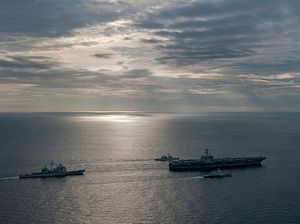This week, Malaysia’s Deputy Defense Minister Johari Baharum laid the keel for the second littoral combat ship (LCS) to be built by France’s Boustead Naval Shipyard for the Royal Malaysian Navy (RMN). The move highlighted the Southeast Asian state’s ongoing attempts at modernizing its navy to address a wide spectrum of challenges even amid its difficult economic position.
As I have noted before, over the past few years, Malaysia has been grappling with the rather grim reality of an aging fleet that needs urgent modernization amid rising manifold threats on the one hand and a political and economic environment that is not conducive to funding much-needed capability boosts on the other (See: “What Does Malaysia’s New Defense Budget For 2016 Mean?”). New defense programs and even some capabilities mulled to help close gaps had been shelved due to budgetary constraints; last year’s defense budget saw the largest cut since 1998 when Malaysia was reeling from the Asian Financial Crisis.
The challenge for the services, including RMN, has thus been how to generate greater efficiency savings to bolster the country’s defenses and address these threats even amid this difficult economic position (See: “Malaysia’s South China Sea Policy: Playing it Safe”). And one of the ways it is trying to “do more with less,” as one Malaysian defense official put it to me, is through the 15-to-5 Armada Transformation Program. The 15-to-5 program would see a reduction of the country’s current 15 classes of vessels, which average 30 years in age and are sourced from seven different countries, to just five categories. These are: Littoral Mission Ships (LMS); Multi-Support Ships (MRSS); Littoral Combat Ships (LCS); New Generation Patrol Vessels; and submarines.
I have explored the current status of some of the individual platforms under the program previously, including the LMS (See: “Malaysia’s New China Warship Deal: Promises and Prospects”). But with respect to the LCS aspect of the 15-to-5 modernization program in particular, Malaysia has ordered six new vessels under a 9 billion ringgit ($2.2 billion) contract awarded to Boustead Naval Shipyard (BNS) back in July 2014. The 111-meter, 3,000-ton platform, based on the Gowind 2500 corvette designed by French shipbuilder DCNS, is to be armed with BAE Systems’ 57mm Mk 3 naval gun, two MSI-Defense Seahawk 30 mm guns, two J+S 324 mm triple tube torpedo launcher systems, and reportedly the Kongsberg Naval Strike Missile anti-ship missile and MBDA VL Mica point defense missile systems, according to IHS Jane’s.
The keel for the first LCS was laid down in March 2016, and the one for the second vessel was laid down by Deputy Defense Minister Johari Baharum this week. According to The Sun, a local media outlet, he also said that the first LCS ship is now 50 percent complete and was expected to be completed by April 2019 before the next iteration of the Langkawi International Maritime and Aerospace Exhibition (Lima). It is unclear if the Southeast Asian state will actually be able to meet this goal. But it would no doubt be a step forward toward a much-needed capability boost as Malaysia seeks to modernize its navy.

































